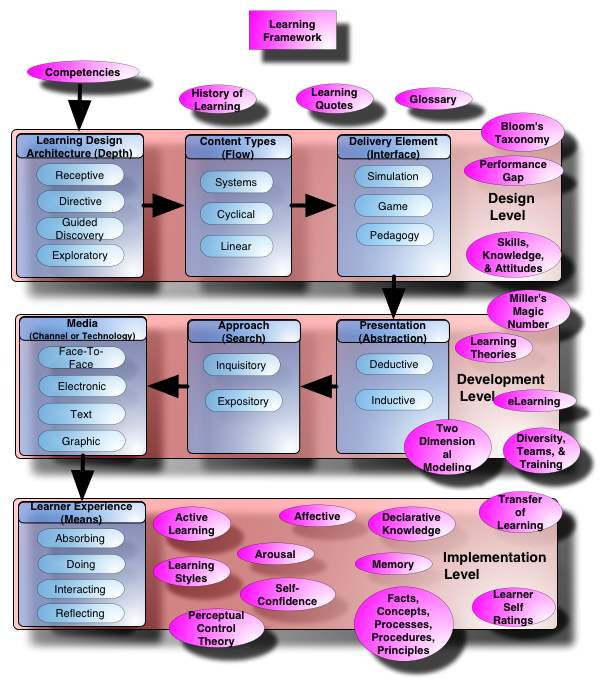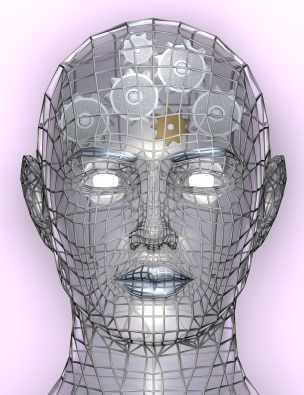Note: This site is moving to KnowledgeJump.com. Please reset your bookmark.
Nonlinguistic Learning Mode in Instructional Design
The nonlinguistic processor encodes experiences as mental pictures, olfactory sensations (smell), kinesthetic sensations (touch), auditory sensations (sound), and taste sensations (Marzano, 1998, p19).
While various linguistic methods are designed into most learning processes, the nonlinguistic and affective modes are often omitted as learning designers do not realize their importance. If any one of these three learning processors are denied or not reinforced, the learning process normally lengthens or is ineffective.
Mental Images
Mental images can increase nonlinguistic retention through the use of such techniques as metaphors, reflection, activities, short videos, images, or storytelling. To truly understand a subject matter we need to be creative with it in order to adapt it to our environment. It is through the power of mental images that we are able to change our mental representations of how things work to how we can make them work for us.
Marzano (1998, p102) reported an effect size of 1.13 (which indicates that achievement can be raised by 37 percentile points) by using techniques that enhance visual memory.
Semantic, Concept, or Mind Mapping
Learners should not only be presented images, such as pictures or videos, they should also create their own. This can be achieved by creating graphic representations when taking notes (connected nodes composed of lines, circles, & drawings). For example:
Learning Models for Pedagogy (click for larger image)
Mind maps work by allowing the learners to organize material into an easy understood visual image that allows them to understand and recall important concepts.
While normal note taking has an overall effect size of .99, indicating a percentile gain of 34 points, graphic representations produced a percentile gain in achievement of 39 points (Marzano, 1998, p91). One of the most effective of these techniques is semantic mapping (Toms-Bronowski, 1982) with an effect size of 1.48 (n=1), indicating a percentile gain of 43 points. With this technique, the learner represents the key ideas in a lesson as nodes (circles) with spokes depicting key details emanating from the node.
Concept mapping was developed by Professor Joseph D. Novak at Cornell University in the mid-sixties and based on the theories of David Ausubel. The reason it works better than normal note taking is that the inner node(s) represent the learner's prior knowledge and then as the learner grasps new ideas or concepts, additional nodes are added to represent them. Thus the learner is able to graph new knowledge built on previous knowledge in a dynamic way rather than through a strictly linear method.
The difference between concept maps, mind maps, Semantic maps is that while concept maps may represent several different, but related concepts, mind maps normally represents one central concept. Thus a mind map may look more like a tree, while a concept map normally looks more as a network with a central node that spreads more or less evenly in all direction.
Semantic maps refer to the whole genre of note taking performed in a graphical manner, thus it includes both concept maps and mind maps.
Mental Imagery

Have the learners practice the task in their minds (visualization)
Mental Imagery, sometimes referred to as visualizing, is quasi-perceptual experience, in that it resembles perceptual experience, but occurs in the absence of the appropriate external stimuli. It has long been used in sports, such as golf and tennis, but has recently been shown to be helpful in learning various mental and physical tasks. Mental Imagery builds upon learning experiences through the means of imagining one self to perfectly perform a set of steps or actions, which in turn builds organized set of propositions that are stored in the brain. These sets of propositions can then be used when one actually performs the task.
The Other Senses
Also, do not forget the other senses. VAK would tell us to let the learners play with a koosh ball, however, I believe this has more to do with personal satisfaction than with actual learning. What really needs to happen is to allow them to touch, move, listen and/or smell the subject mater if at all possible... sort of what Zen is built upon—become one with the subject.
Next Steps
Next chapter: Linguistic Learning Mode
Return to the introduction: Introduction: The Three Representational Modes
References
Marzano, Robert J. (1998). A Theory-Based Meta-Analysis of Research on Instruction. Mid-continent Aurora, Colorado: Regional Educational Laboratory. Retrieved from http://eric.ed.gov/?id=ED427087#sthash.iDenYiIh.dpuf
Plessinger, A. The Effects of Mental Imagery on Athletic Performance. Retrieved from http://www.vanderbilt.edu/AnS/psychology/health_psychology/mentalimagery.html
Toms-Bronowski, S. (1982). An Investigation of the Effectiveness of Semantic Mapping and Semantic Feature Analysis with Intermediate Grade Level Children. University of Wisconsin: Wisconsin Center for Education Research. Retrieved from http://eric.ed.gov/?id=ED224000



